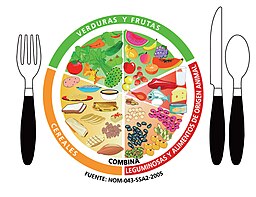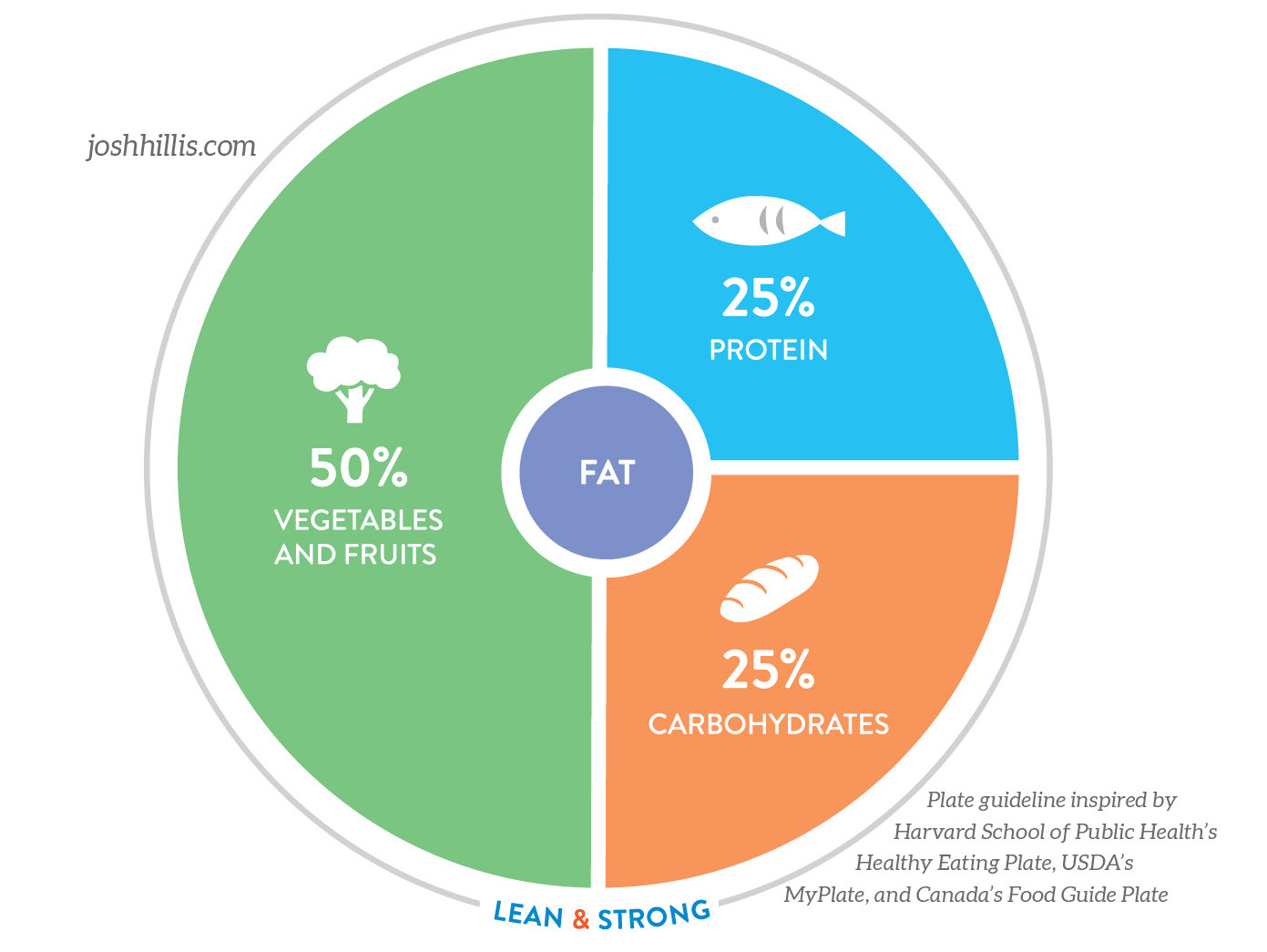
Above are three plate guidelines:
- Healthy Eating Plate from Harvard School of Public Health and Harvard Medical School
- MyPlate from the United States Department of Agriculture
- Canada’s Food Guide from Health Canada
Two are directly from governments — the United States and Canada. One is from a world-renowned school of public health, Harvard-Chan (and with Harvard Medical School), and created as a response to MyPlate.
All of them have three things in common:
- Half of the plate is fruit and vegetables
- A quarter of the plate is protein
- A quarter of the plate is carbohydrates
I think that that’s a pretty fair place to start. If that’s most of what you paid attention to, food wise, you’d be having really reasonable, balanced meals. We should probably all keep it that simple.
Biggest Differences: 1. What to drink, 2. Dairy, 3. Fat
- What to drink: Both Healthy Eating Plate and Canada’s Food Guide recommend drinking water on their plate guideline, MyPlate recommends drinking milk.
- Healthy Eating Plate and Canada’s Food Guide recommend reducing fruit juice, while MyPlate puts 100% fruit juice in the fruit section of the plate.
- Dairy: MyPlate says to have a serving of dairy with your meal. Healthy Eating Plate and Canada’s Food Guide both deliberately removed dairy as a separate food group.
- Canada’s Food Guide puts dairy in the protein section.
- Healthy Eating Plate recommends limiting dairy to 1-2 servings per day.
- Healthy Eating Plate says to make sure to get enough calcium from dairy or plant sources.
- Fat: Healthy Eating Plate has plant oils on the plate guideline. Neither MyPlate nor Canada’s Food Guide show fat as a group on their plate graphics.
- MyPlate actually does talk about getting healthy fats here.
MyPlate limits healthy oils to 2.5-3 tablespoons per day for women, and 3-3.5 tablespoons per day for men. They talk about the difference between trans fats, saturated fat, unsaturated fat here. 2023 update: MyPlate now recommends reducing solid fats/saturated fats, but does not have a limits for plant based or fish based fats. - Canada’s food place also talks about getting healthy fats here, getting fat from fish and plant oils (while reducing saturated fat). Health Canada’s stance is that “the type of fat you eat over time is more important for health than the total amount of fat you eat,”
which turns out to be the same as what Harvard-Chan recommends. - Harvard School of Public Health 2023 update: They now recommend plant oils and fish for fat “in moderation” (instead of unlimited, like before). They still recommend reducing/avoiding saturated fat.
- MyPlate actually does talk about getting healthy fats here.
What about El Plato del Bien Comer?

I didn’t include El Plato del Bien Comer from Mexico’s Ministry of Health, mostly for simplicity. The other three plates have the same percentages in each section, while El Plato del Bien Comer is slightly different.
That being said, let’s take a quick look: El Plato del Bien Comer has three main groups:
- 1/3 fruit and vegetables
- 1/3 grains and tubers
- 1/3 legumes and animal protein
So, it’s basically going the same direction, just thirds instead of the half and quarters of the others. I think it’s a totally great guideline — at some point I might re-write this article with it more in the mix. For now, out of laziness, I’m just comparing the three that are more visually similar.
Eat Balanced-ish Meals
From a weight loss perspective, the cool thing about balanced meals is that they typically have us feel the most full, for the longest, for the least amount of food energy (calories).
Feeling full is cool. And, per recommendations above, there’s a fairly solid consensus that it’s healthy to eat balanced meals.
I thought this post would be fun, just to take a look at some science based recommendations on what that balance should look like. Harvard-Chan argues that their plate is based on more up-to-date science than USDA’s MyPlate. That’s all above my pay-grade to figure out. I’m always more interested in what they all have in common.
And again, what they all have in common:
- Half of the plate is fruit and vegetables
- A quarter of the plate is protein
- A quarter of the plate is carbohydrates
- Choosing unsaturated fats (like plant oils, avocado, nuts, or fish)
Heck, most people would lose weight if they just added more vegetables (it would crowd out calories from other stuff). Most people are wasting tons of energy on magical foods or overly-restrictive diet rules that don’t make a difference. In reality, if you had one serving of rice instead of five, and one serving of fajita chicken, and filled in the rest of the plate with vegetables, you’d be doing totally fine from a weight loss perspective.

The plate guideline from my book, Lean & Strong, you’ll notice, matches all three plate’s guidelines for vegetables and fruit, protein, and carbohydrates.
Two differences:
- The fat being is added to the plate graphic, is inspired by the Harvard School of Public Health’s Healthy Eating Plate, but matches the recommendations for fat in Canada’s Food Guide and MyPlate, if you go beyond the plate. 2023 update: Their new guidelines seem to be coming even more in line with Healthy Eating Plate on fat.
- Dairy was only in USDA’s MyPlate, and not in Canada’s Food Guide or Harvard’s Healthy Eating Plate, so I dropped that.
I tried to work with what they all had in common. It may be slightly leaning towards the Healthy Eating Plate.
I believe that this is a reasonable combination of all three. Also think that, as a coach, I can justify this recommendation being within my scope of practice, based on the government departments and public health institution that that it comes from.
Of course, this is all just to give you a sense of what balanced-ish meals could look like. Your version of balanced could be different. Look at all three guidelines and make your own decisions. Also, if you aren’t in North America, compare and contrast these plate guidelines with your own country’s nutrition guidelines.
I’m all about working on more interesting behavioral skills with clients, like eating when hungry, noticing when full, distinguishing between stress and hunger, and so on. But it would be silly to not hit the really low hanging fruit like eating a balanced meal.
The simple stuff is stimple… but it still makes a big difference when you actually do it. Do the simple stuff, get that handled, and then move on to the more complex stuff.
—Josh Hillis
P.S. I wrote this post mostly for myself, because I thought it would be fun to compare and contrast the three plate guidelines.
P.P.S. I think this post will also be fairly useful for personal trainers. As personal trainers, to stay inside of our scope of practice, we need to stick to sharing information from large, credible institutions.
P.P.P.S. By sticking to sharing these simple guidelines from the USDA, Health Canada, and Harvard-Chan, we can stop wasting time talking about the minutiae of diet rules that don’t matter. Then we’re freed up to focus on the things that do matter, like eating behavior (not mindlessly snacking, eating slowly, cooking more often, and so on) and how eating behavior impacts total food energy consumed.
Clients are always shocked that I don’t care about the precise content of what they are eating. I almost never ask or talk about it. I’ve had clients who really wanted to do keto, mediterranean, paleo, zone, or vegan, or whatever — they can do what they want. From a well-being standpoint, I wish they didn’t follow any named diet at all, but that’s another story.
I’ve been pouring over weight loss research for five years now, and haven’t found evidence that any individual diet matters at all, so I don’t care what they do, I just make sure that they reflect on what is or isn’t working for them about what they do.
I don’t coach nutrition, I coach behavior. Clients get results because they change their behaviors.
Usage of plate graphics: Fair use and public domain
USDA MyPlate: Public Domain, via Wikimedia Commons: https://commons.wikimedia.org/wiki/File:USDA_MyPlate_green.svg
Original source: https://www.myplate.gov/
Canada’s Food Guide Plate: Fair use, via Wikimedia Commons: https://en.wikipedia.org/wiki/File:Canada%27s_Food_Guide.png
Original source: https://food-guide.canada.ca/en/
Harvard School of Public Health Healthy Eating Plate: Fair use
Source: https://www.hsph.harvard.edu/nutritionsource/healthy-eating-plate/
Mexico’s Ministry of Health’s El Plato del Bien Comer: Fair use
Source: https://commons.wikimedia.org/wiki/File:El_Plato_del_Bien_Comer_Tomado_de_NOM-043-SSA2-2005.jpg
Fair use rationale:
- Portion used: Entire work. Each entire image is required to avoid misrepresenting it’s guidelines.
- Low resolution: These copies are much smaller and significantly lower resolution than the original. Copies made would be unsuitable for commercial purposes. At this small size, none of the individual images are not easily readable. In no way do any of these serve as a replacements for the originals.
- The Harvard School of Public Health “Healthy Eating Plate” image used here is only 4% of the size of the original. The Mexico Ministry of Health’s El Plato del Bien Comer is a very small image, at only 256px.
- Purpose: This image is necessary for commentary and critical review of the work. The image conveys what words alone could not.
- Replaceable: These works are not replaceable by free or purchasable content. Any version that is not true to the original would not work for commentary, and could be misleading.
- Transformative: The three guidelines are grouped together in a new way to compare and contrast them. The three small images together is different from any of the three images on their own, at full size. The commentary comparing and contrasting the three of them expands and transforms how any of them would show up in isolation.
Excellent stuff, as always!